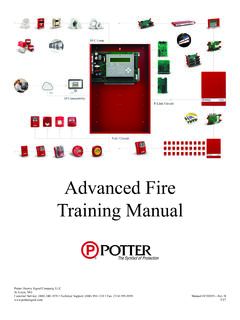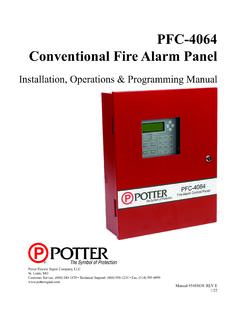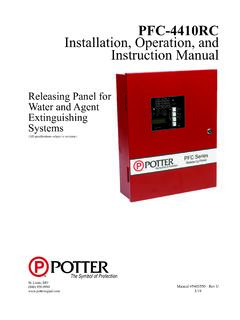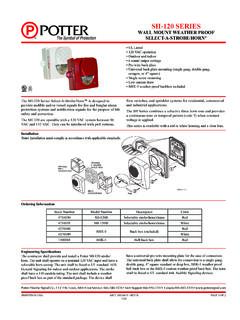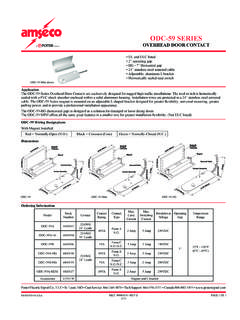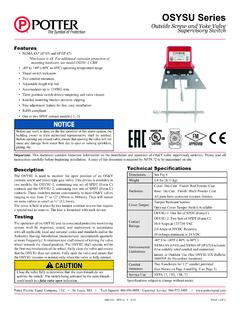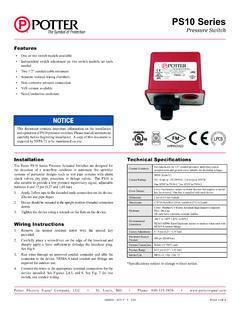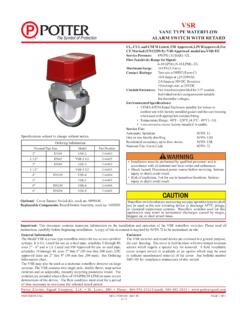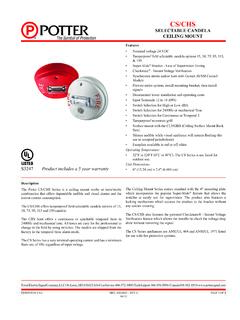Transcription of AFC-50 Fire Alarm Installation Manual
1 AFC-50 fire Alarm Installation ManualDocument 5403647-Rev. F12/20 Potter Electric Signal Company, LLCSt. Louis, MO Customer Service: (866) 240-1870 Technical Support: (866) 956-1211 Fax: (314) 595-6999 For listing information visit our website Installation Manual -5403647-REV F 12/201. Installation Wiring DocumentsFigure 1. AFC-50 Addressable fire Panel Wiring DiagramType of CircuitVoltage TypePower TypeAC ConnectionHigh VoltageNon-Power LimitedBattery ConnectionLow VoltageNon-Power LimitedTrouble RelayHigh VoltageNon-Power LimitedSupervisory RelayHigh VoltageNon-Power LimitedAlarm RelayHigh VoltageNon-Power LimitedI/O CircuitsLow VoltagePower LimitedNotification Device Circuits (NACs)Low VoltagePower LimitedP-Link RS-485 ConnectionsLow VoltagePower LimitedSignaling Line CircuitLow VoltagePower LimitedPhone Line DACTHigh VoltagePower LimitedDWG #640-1 PLINKB attery connection (non-power limited).
2 Use two(2) 12V batteries connected in relays are non-power limitedTO P-LINK DEVICESTO PAD100 SLC DEVICES120 VAC 50Hz~60Hz240 VAC 50Hz~60 HzConnect to separate unswitched AC circuit120/240 VACJ umper PositionNAC 2 NAC 1I/O1I/O2 SLCEOL120|240120|2403 AFC-50 Installation Manual -5403647-REV F 12/20 Main Supply CircuitThe AC terminals are located in the upper left hand portion of the main board. The main board supervises the main AC power and provides indication that the AC power is 2. Main Supply CircuitThe terminals are rated at 120 VAC/240 VAC 50/60 Hertz and are marked so accordingly on the board. The earth ground connection is marked as G and is the furthest connection from the line voltage connection.
3 The AC input power ratings: Maximum of 5A at the nominal 120 VAC of 3A at the nominal 240 VAC Battery CircuitThe battery charging circuit is provided on the main panel in the lower left portion of the board. Terminal connections are provided to connect wire leads for battery connection. The battery must be a recognized or listed sealed lead acid battery or equivalent. The battery charging voltage is approximately VDC and the circuit is supervised. The battery circuit is protected with a non-replaceable 7 amp poly switch located on the main circuit board. The maximum battery charging circuit is amp DC.
4 The battery circuit is rated for 8 to 55 AH batteries and the cabinet will house up to two 18 AH batteries. The batteries will operate the panel for at least 24 hours and 5 minutes of Alarm . In order to determine the minimum size batteries for standby and Alarm times desired, the installer must complete a battery calculation work sheet in order to determine the minimum battery size for a particular application. For reference, the battery calculation work sheet is attached as Appendix A. Complete standby battery calculations must be completed to ensure adequate battery sizes are #593-6 BWGAC120V/AC230V,50/60 HzAC POWERB lackWhiteGround120 VAC 50/60 Hz240 VAC 50/60 HzConnect to separateUnswitched AC circuit4 AFC-50 Installation Manual -5403647-REV F 12/20 Figure 3.
5 Battery Circuit ConnectionsSeparation of Circuits - Power Limited, Non-Power Limited, High Voltage WiringThe main AC power connection is considered high-voltage and non-power limited. The phone line connections to the DACT are high-voltage power limited. Battery conductors, and the Alarm , supervisory, and trouble relays are non-power limited. All remaining circuits are low-voltage, power limited separation must be maintained between the circuits listed above. All separations in the different wiring must be maintained by at least inches and the wire insulation must be for the higher voltage. In the panel there are sufficient knock outs located around the periphery of the cabinet to allow the installer to maintain power limited and non-power limited connections.
6 The main AC power connection should be made on the left side or top left of the cabinet. The DACT wiring connections should be made along the top right side of the Appliance Circuits (NACs)The panel is equipped with two NAC circuits and each are rated for a continuous 3 amps at 24 VDC. The outputs are supervised and regulated. The NACs reverse polarity upon activation and the board and illustrations are marked accordingly. The panel can be programmable to allow for addition of a CA-6075 Class-A Expander. This expander allows for Class A operation of the NACs. Each Class A circuit is rated for a continuous 3 amps at 24 VDC.
7 The outputs are supervised and circuits are power limited and the type of output is selectable. The NACs may be configured for strobe synchronization with AMSECO, Wheelock, Gentex, or System Sensor strobe devices as shown compatible in this document and the Installation instructions. The maximum impedance is a function of the load being applied to the circuit. In order to calculate the maximum impedance as follows:( Alarm Current of Notification Appliances) X (Wire Resistance) < 3 volts. The NAC circuits may be configured for Class A or Class panel has ground fault detection on the NAC circuits. The impedance to ground for ground fault detection is 0 #593-5 PanelConnectionsBATTERY-+12 V Battery-+12 VBattery-+5 AFC-50 Installation Manual -5403647-REV F 12/20 Figure 4.
8 Class B NAC WiringFigure 5. Class A NAC Wiring Requires CA-6075 The end of line resistor is a ohm resistor. The resistor assembly has been evaluated in past projects and is a standard in the Potter panel product line. The Potter part number for the listed end of line assembly is 3005013 EOL Resistor #602-4 ANAC 1 NAC 2-+ -+ EOLP otter Part #3005013 Notifica tion ApplianceDWG #602-5 BNAC 1 NAC 2-+ -+Notifica tion ApplianceNAC 1 NAC 2-+ -+6 AFC-50 Installation Manual -5403647-REV F 12/20I/O CircuitsThe panel is equipped with two I/O circuits.
9 The I/O circuits can be configured as either an input or an output. The I/O circuits can be used in Class B mode Circuit as InputsAs inputs, the I/O circuits are used as a dry contact monitoring inputs, and are power limited and wiring resistance = 100 wiring capacitance = 1 wire length = 10,000 IDC voltage = 24 VDCM aximum IDC current = 15 maThe circuit can be configured for the same selection of contact input functions as the SLC MCM and SCM modules. I/O Circuit as Outputs (NAC)As outputs, each of the I/O circuits is rated for 1 amp continuous current at 24 VDC. The outputs are supervised and regulated.
10 The circuits reverse polarity upon activation and the board and illustrations are marked accordingly. The circuit is power limited and the type of output is selectable. I/O circuits may be configured for strobe synchronization with AMSECO, Wheelock, Gentex, or System Sensor strobe devices as shown compatible in this document and the Installation instructions. The maximum impedance is a function of the load being applied to the circuit. In order to calculate the maximum impedance as follows:( Alarm Current of Notification Appliances) X (Wire Resistance) < 3 volts. The panels have ground fault detection on the I/O circuits.
